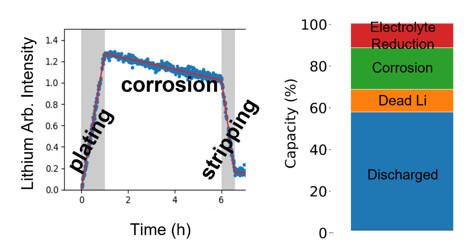
Batteries are a key technology for electrifying transportation and using domestic, renewable energy sources. However, a major limitation of electric vehicles (EVs) is the lower energy density compared to gasoline, meaning the range on a full “tank” is smaller. Li-metal is a promising, high-capacity electrode that could provide energy-dense batteries, extending the range for EVs.
In a lithium metal electrode, lithium is electroplated and stripped from a substrate, but the process is not yet efficient enough due to capacity losses. Multiple degradation pathways, including electrolyte reduction, lithium corrosion, and the formation of disconnected (dead) lithium, contribute to these capacity losses, but few methods of characterization can distinguish the various modes of degradation.
In a recent study, researchers at SSRL developed a method of monitoring the amount of lithium metal in the electrode via operando x-ray diffraction (XRD) at SSRL. Throughout cycling, the method measures how much lithium is actively cycled, how much dead lithium develops, and how the lithium metal corrodes, leading to a quantitative understanding of the various degradation pathways.
Additionally, the characterization method provides a unique measure of the corrosion rates of electrodeposited lithium metal. The measurements reveal that lithium corrodes when electrically connected to substrate, as well as in the form of dead Li metal, which is no longer connected. Observation of these different corrosion rates provides new insight into their mechanisms in lithium metal batteries.
Through operando XRD experiments at beamlines 7-2 and 11-3 at SSRL, the researchers demonstrated a new characterization approach for understanding cycling inefficiencies in lithium-metal electrodes. The results in the study address the need for quantification of capacity losses and better understandings of degradation mechanisms, both of which can aid in the design of long-lasting, high energy-density batteries.
N. R. Geise, R. M. Kasse, J. N. Weker, H.-G. Steinrück and M. F. Toney, "Quantification of Efficiency in Lithium Metal Negative Electrodes via Operando X-ray Diffraction", Chem. Mater. 33, 7537 (2021) doi: 10.1021/acs.chemmater.1c02585




